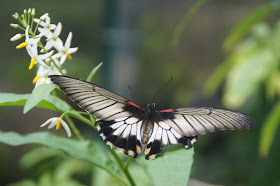 |
| LDub covered with a Giant Atlas Moth. If you look closely you can see my mouth and teeth through the moth. Click to enlarge. |
 |
| Molly, our tour guide for our trip through the St. Martin Butterfly Farm. She is holding another Giant Atlas Moth. |
 |
| One of many types and colors of caterpillars that we found in the Butterfly Farm. |
 |
| One of a few boxes where the pupas are place until the butterflies or moths emerge from them. |
 |
| Here is a tree with a few of the Giant Atlas Moths clinging to it. |
 |
| This is Tito. He answered a few questions we had while exploring the farm on our own after the tour. |
 |
| Carol's new hairpiece, the Giant Atlas Moth. |
 |
| I realize this isn't a butterfly or moth, but though it was and interesting shot. |











No comments:
Post a Comment